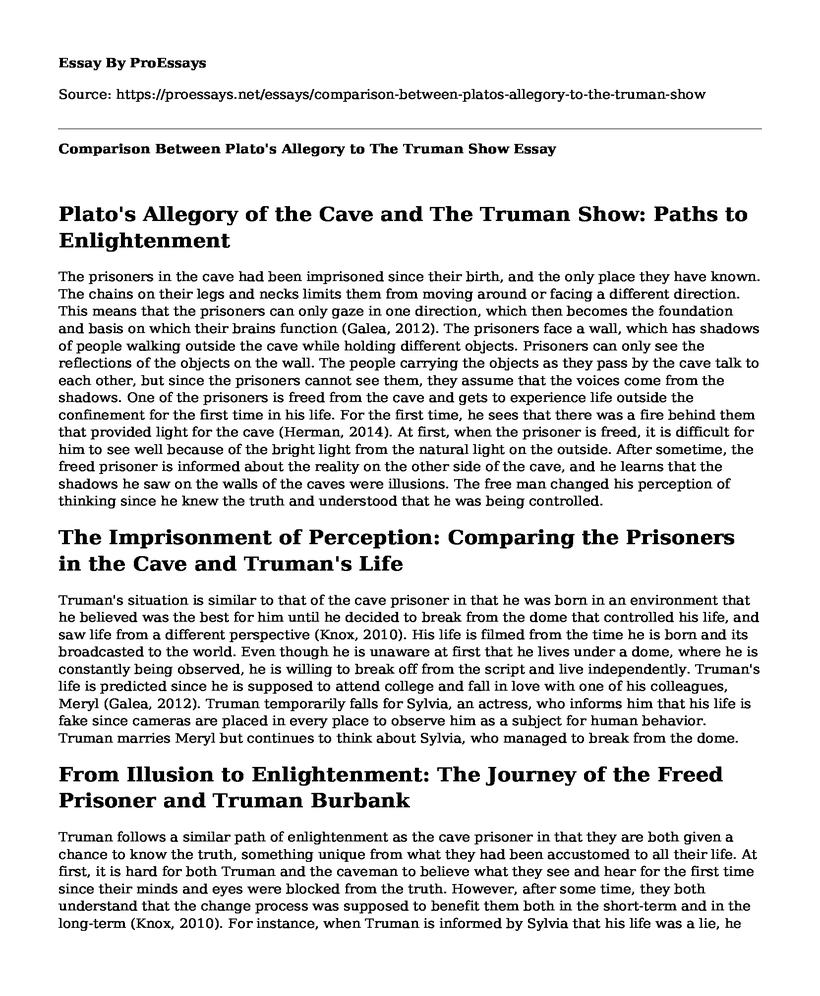Plato's Allegory of the Cave and The Truman Show: Paths to Enlightenment
The prisoners in the cave had been imprisoned since their birth, and the only place they have known. The chains on their legs and necks limits them from moving around or facing a different direction. This means that the prisoners can only gaze in one direction, which then becomes the foundation and basis on which their brains function (Galea, 2012). The prisoners face a wall, which has shadows of people walking outside the cave while holding different objects. Prisoners can only see the reflections of the objects on the wall. The people carrying the objects as they pass by the cave talk to each other, but since the prisoners cannot see them, they assume that the voices come from the shadows. One of the prisoners is freed from the cave and gets to experience life outside the confinement for the first time in his life. For the first time, he sees that there was a fire behind them that provided light for the cave (Herman, 2014). At first, when the prisoner is freed, it is difficult for him to see well because of the bright light from the natural light on the outside. After sometime, the freed prisoner is informed about the reality on the other side of the cave, and he learns that the shadows he saw on the walls of the caves were illusions. The free man changed his perception of thinking since he knew the truth and understood that he was being controlled.
The Imprisonment of Perception: Comparing the Prisoners in the Cave and Truman's Life
Truman's situation is similar to that of the cave prisoner in that he was born in an environment that he believed was the best for him until he decided to break from the dome that controlled his life, and saw life from a different perspective (Knox, 2010). His life is filmed from the time he is born and its broadcasted to the world. Even though he is unaware at first that he lives under a dome, where he is constantly being observed, he is willing to break off from the script and live independently. Truman's life is predicted since he is supposed to attend college and fall in love with one of his colleagues, Meryl (Galea, 2012). Truman temporarily falls for Sylvia, an actress, who informs him that his life is fake since cameras are placed in every place to observe him as a subject for human behavior. Truman marries Meryl but continues to think about Sylvia, who managed to break from the dome.
From Illusion to Enlightenment: The Journey of the Freed Prisoner and Truman Burbank
Truman follows a similar path of enlightenment as the cave prisoner in that they are both given a chance to know the truth, something unique from what they had been accustomed to all their life. At first, it is hard for both Truman and the caveman to believe what they see and hear for the first time since their minds and eyes were blocked from the truth. However, after some time, they both understand that the change process was supposed to benefit them both in the short-term and in the long-term (Knox, 2010). For instance, when Truman is informed by Sylvia that his life was a lie, he ignores her, but he is eventually motivated to go and seek the truth about his life. He realizes that Sylvia was correct. On the other hand, the freed prisoner has a hard time adjusting to the life outside the cave, but once he opens up his eyes, he realizes that he had been mentally and physically been limited from knowing the truth. In conclusion, Plato's allegory of the cave and the Truman Show follow a similar script as both the caveman and Truman are enlightened on the path of life.
References
Galea, S. (2012). Reflecting reflective practice. Educational philosophy and theory, 44(3), 245-258.
Herman, A. (2014). The cave and the light: Plato versus Aristotle, and the struggle for the soul of western civilization. Random House Trade Paperbacks.
Knox, S. (2010). Reading" The Truman Show" Inside Out. Film Criticism, 35(1), 1-23.
Cite this page
Comparison Between Plato's Allegory to The Truman Show. (2022, Mar 27). Retrieved from https://proessays.net/essays/comparison-between-platos-allegory-to-the-truman-show
If you are the original author of this essay and no longer wish to have it published on the ProEssays website, please click below to request its removal:
- Essay Sample on Transcendentalism and Self-Identity: Dickinson and Whitman's Poetry
- Poetry Analysis Essay on Images of Hope in Alfred Prufrock in 'The Love Song' by T.S.Eliot
- Essay Sample on Girl by Jamaica Kincaid And All the World's A Stage
- Essay Example on Aristotle vs. Plato: Comparing Views on Knowledge
- Paper Example on Establishing Identity: Interaction, Material Worlds, & Social Behaviors
- Essay Example on Promise-Keeping: Morally Crucial for Trust, Security and Character
- Ethical Issues in Proposing GameRush, Inc: Upholding Professionalism - Essay Sample







